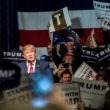There was a moment of reckoning on election night when the enormity and irreversibility of what was taking place across the nation hit home with the force of a jackhammer. The talking heads were looking at two state maps, first Pennsylvania and after that Wisconsin, both enlarged on the screen so that each state was a jigsaw puzzle of its component counties. Seen this way, these rural, under-populated counties acquired a new weight, occupying essentially the same proportion in relation to their states as the states did to the whole country on the national map. And they were all red, a vast, unvarying mass of incontrovertible and indisputable red, every one of them carried by Trump.
So how did this happen, and what does it mean? Democrats have been watching white voters flee since LBJ signed the 1964 Rights Act. Many more drifted to Reagan, staggered by double-digit inflation, their national pride wounded by the defeat in Vietnam and the hostage-taking in Iran. A large number of these defections were from traditional households or families with longstanding ties to labor unions—or both—many of whom felt out of sync with the changes demanded by the women’s movement and environmentalists. Prodded by the likes of Richard Viguerie and Karl Rove, national Republicans also embraced the Religious Right, and for a time the so-called values voter was perceived to hold a veto on the shape of the GOP ticket.
The nation then fell in love with Barack Hussein Obama, part of whose genius as a candidate was to free up white voters to vote for a black man—by not blaming them for insensitivity to the black experience, and by identifying with the genuine aspects of their own predicament. Still, extremists in what was left of the Republican party were stirring, and the nihilist Tea Party injected white anger into the policy debate, forcing the Republicans further to the right and elevating obstructionism to a political art form.
All these historical strains surfaced again in the election of 2016. The populist left, cosmopolitan liberals, and mainstream Democrats all despair over Trump’s agenda, and to be sure his proposals, to the extent that they are known, or real, are profoundly dispiriting. But on top of that, Democrats are offended by Trump, offended that this egregious lout could be welcomed in the halls of Congress, their Congress (though Republicans have been in control off and on for a generation). Their candidate Hillary Clinton ran an entire campaign against Trump on the grounds that he was unsuited for the presidency.
Not so with the Trump voter, many of whom were first-time voters, or had voted for Obama, or hadn’t voted in years. We now know quite a lot about the Trump voter, and certainly more than the hapless pollsters who grossly underestimated Trump’s appeal. Rick Perlstein, the Spectator’s national correspondent, cautioned against reading too much into the polls from the start, and early on recognized the signs of populism on both sides. He also understood the basis of Bernie Sanders’s appeal to working-class voters and anti-establishment progressives: “Make full-throated appeals to ordinary people’s economic interests and frame what Teddy Roosevelt called ‘the malefactors of great wealth’ as the enemy, and you could crack the political world wide open.”
In The Populist Explosion, John Judis distinguished populism on the right and the left this way: “Leftwing populists champion the people against an elite or an establishment. Theirs is a vertical politics of the bottom and middle arrayed against the top. Rightwing populists champion the people against an elite that they accuse of coddling a third group, which can consist, for instance, of immigrants, Islamists, or African American militants.” The stage was set for break-away Democrats to anoint Bernie Sanders, and whites with grievances to embrace Donald Trump.
Democrats are offended by Trump, offended that this egregious lout could be welcomed in the halls of Congress, their Congress.
Yet, as ProPublica’s Alec MacGillis suggests in his masterful reporting from Pennsylvania and Ohio, the Trump voters are not always who we thought they were. MacGillis cites three common denominators—they live in places that are in decline, they lack strong attachments to either party, and they carry a profound contempt for a dysfunctional Washington. It’s a perverse tribute to the political skill of the Republicans, and an indictment of the inattentiveness of their audience, that the GOP could oppose every Obama initiative, bring the federal government to the edge of the precipice more than once, and still reap the support of those who were angry at the do-nothing Congress. For liberals, this runs parallel to their recognition that the greatest political achievement of the right is to have made their victims their most ardent supporters.
MacGillis talked to union members who voted for Trump, and to women who had experienced sexual harassment who voted for Trump. He spoke to people who railed against political correctness, people who were concerned about their jobs being shipped to Mexico, people who were overqualified for their jobs, people who thought their country was going in the wrong direction, people who couldn’t imagine Hillary as Commander-in-Chief—and all of them voted for Trump. As Paul Waldman of the American Prospect pointed out, “Hillary Clinton could have kidnapped every one of those voters and forced them to listen to her read her plan for paid family leave, and it wouldn’t have made a difference, because Trump was reaching them on a much more visceral level.”
Political strategists have an axiom about campaign narratives—never let the opposition tell your story. Republicans consumed two years and an estimated $7 million dollars on the House Select Committee on Benghazi investigation. Democrats decried the hearings as a politically motivated show trial aimed at damaging Hillary Clinton’s presidential prospects. The committee’s final report found no new evidence of wrongdoing on Clinton’s part and essentially confirmed the findings of the seven previous investigations into the Benghazi tragedy. Clinton was quoted in The New York Times saying the hearings had a “partisan tinge” and Vanity Fair dubbed the final report a “dud.” But in the red counties of industrial Pennsylvania and Ohio, and the rural areas of Wisconsin, the damage was done.
The Benghazi investigation also produced another goldmine for Republicans—the controversy over Clinton’s use of a personal email server while secretary of state, which was first reported in The New York Times based on information provided by the Benghazi investigators. Clinton was cleared by the FBI in July of this year, and cleared again by FBI Director Comey two days before the election and a week after he had bizarrely announced the FBI was reopening the investigation. Yet in interviews across the “Blue Wall” of industrial states, Trump voters cited Benghazi and the emails as part of their calculus.
Trump won, as Robert Borosage of Ourfuture.org has observed, without a campaign apparatus and without the support of many of the leaders of his own party. His campaign was out-spent and out-organized, his tax dodges were exposed and a video documenting his predatory sexist boasts was reinforced by the testimonies of several of his victims. Trump, the billionaire buffoon, presented himself as the quintessential outsider, and Clinton, unable or unwilling to put forth a compelling vision of fundamental change, wrapped herself in Obama. Among the 39 percent of voters who considered change the most important quality of a candidate, in CNN exit polling, Trump led 83 percent to 14 percent.
So now what? It’s easy to guess at where a right-leaning Republican Congress is headed, but harder to intuit where a Trump presidency will take them. Trump provided a window onto his tactics in his 1987 book The Art of the Deal. “The final key to the way I promote is bravado. I play to people’s fantasies. People may not always think big themselves, but they can still get very excited by those who do. That’s why a little hyperbole never hurts. People want to believe something is the biggest and the greatest and the most spectacular. I call it truthful hyperbole. It’s an innocent form of exaggeration—and a very effective form of promotion.”
Banning Muslims and building a wall on the border with Mexico are more likely to end up in the landfill of Trump’s little hyperboles than as cornerstones of his legislative action program. He has called on the United States to withdraw from the Middle East and suggested Japan and other nations provide for their own defense—neither of which seem likely to survive the vetting of contemporary realpolitik.
In this context, it could even be argued he could walk back his threats to undo NAFTA, and to tear up the Iran deal and the Affordable Care Act (parts of which he recently said he “really likes”). Reports suggest his advisers are looking for a way out of the Paris climate accord, though both China and India issued stern warnings shortly after the election informing the president-elect that he would be defying the wishes of the entire planet if he withdrew from the agreement.
Whatever he decides about the international agreements, the environment is in for a beating. As reported in The Washington Post, there is little in Trump’s pro-business record or rhetoric to suggest he will not follow through on his promise “to roll back Obama’s signature effort to reduce greenhouse-gas emissions, known as the Clean Power Plan, and to scrap the litany of other ‘unnecessary rules’, especially those imposed on the oil, gas and coal sectors.”
Trump has already tapped Myron Ebell, an oil industry mouthpiece and recipient of Koch brothers’ largesse, to oversee the transition at the EPA. Ebell sees the environmental movement as alarmist and overzealous, and according to the Post “has argued for opening up federal lands for logging, oil and gas exploration and coal mining, and for turning over more permitting authority to the states.” Ebell, unsurprisingly, questions the international consensus that human activity plays a role in driving global warming.
Yet if we’re counting on the Trump voter to object to this new direction, we have a lot of work to do. In Strangers in Their Own Land, Arlie Hochschild reports that the victims of severe environmental degradation hate the Environmental Protection Agency as much as the large corporations responsible for the damage, and regularly vote for candidates who want to shut down the agency. One of her subjects tells Hochschild, without a trace of irony, “Pollution is the sacrifice we make for capitalism.”
Trump and his congressional allies, following the Republican playbook, will almost certainly lower taxes on corporations and the wealthy (though as an ordinary citizen Trump called for increasing taxes on the wealthy to pay off the national debt). They’ll also roll back the regulatory reforms imposed on Wall Street, which were adopted in response to the worst recession since the Great Depression. On the spending side, Trump and his advisers have talked about expanding the military budget and rebuilding infrastructure, emphasizing the jobs that come with that essential investment. Of the economic policy options, infrastructure spending may enjoy the most bi-partisan support and if enacted could suggest a pragmatism behind the bombast of the new president. He has indicated he plans to pay for his tax-cuts and increased spending by repatriating the money corporations have stashed offshore, closing tax loopholes enjoyed by the rich, and cutting unspecified social programs. But even if these changes spur economic growth in the short term, no one can make the math work, and there is deep skepticism that the economy can grow enough to offset the anticipated deficits.
It will be interesting to see whether the populist white workers in Pennsylvania and Ohio and the rural white voters in Wisconsin are buying, or if they sense the first intimations of betrayal.
Trump, who may turn out to prefer the hustings to the executive office, will try to sell tax cuts and infrastructure spending as a first step toward making America great again, and it will be interesting to see whether the populist white workers in Pennsylvania and Ohio and the rural white voters in Wisconsin are buying, or if they sense the first intimations of betrayal.
Perhaps more important, we’ll discover how quickly progressives find their voice in advance of the coming storm. The battle is already on for leadership of the Democratic Party, with progressives like Congressman Keith Ellison (D-MN) arguing for a new politics that digs out from under the rule of big money and offers a fair economy and a decent standard of living across all demographic lines.
Absent the presidential veto, other pet projects of the right are presumably back on the table. The Republican base has wanted to cut off NPR and public television for years, even though NPR stations now receive on average only about 10 percent of their revenues from the Corporation for Public Broadcasting. The tireless Viguerie recently declared “we are teed up to defund Planned Parenthood.”
And Trump, who was once pro-choice, has vowed to make the Hyde Amendment, which prevents taxpayer dollars from being used for abortion and is extended by Congress each year, a permanent law. These battles are preludes of course to the showdown over current and future vacancies on the Supreme Court, which Trump has promised to re-make with justices in the mold of Antonin Scalia. Abortion rights and affirmative action were on the winning side in recent majority decisions that would probably require two new appointments to overturn. But in the long run, a 7-2 conservative court composed of comparatively young judges is a nightmarish possibility.
These early days in Trumpland abound with ironies. Trump appointed family members—his daughter Ivanka, his son Donald Jr., and son-in-law Jared Kushner—to the transition team charged with charting the course of the federal government for the next four years. Yet we have Kushner to thank for blocking Chris Christie’s path to the vice-presidency, and now for helping to remove the dissembling New Jersey Governor from his perch at the head of same inner circle. In addition to public and official skepticism over his role in the George Washington Bridge lane-closure scandal, Christie is apparently paying the price for his successful 2004 prosecution of Charles Kushner, Jared’s father, for illegal campaign contributions, tax evasion, and witness tampering.
Another deeper irony beckons in the weeks and months following the inauguration, when Democrats, who have very few options to leverage their opposition to the right’s agenda, may find themselves turning to Trump the pragmatist to tame the more extreme impulses of the Republican Congress.
For more than a year Trump’s “truthful hyperboles” and barbaric campaign persona have played to the fantasists on the right and on the left, where few beyond Michael Moore understood the reach of his appeal. Conservatives are salivating at the prospect of unfettered control over the three branches of government, and the left in its different guises is gearing up for mobilization. Either we have elected an opportunistic, conservative businessman who is only just beginning to understand the constraints on his office, or we are standing on the doorstep of the apocalypse.
Hamilton Fish is The Washington Spectator’s publisher and editorial director.







Michigan 300,000 votes less than Obama in 2012 (75,00 Black voters accepted the boycott challenge); North Carolina 2 million black votes decided to stay home; Wisconsin 230,000 fewer; and Pennsylvania 130,000 blacks said no this year to the Democratic Party. This is how black America (Todd Elliott Koger) helped make Donald Trump our 45th President.
The Democrats had always thrown shade in our direction. Black Lives Matter’s founders put in writing their “rejection” of us because their stated agenda was “LGBTQ” issues. In June 2016, Donald Trump was the only one willing to listen to us. We explained to Mr. Trump that we had been voting almost 50 years “straight” Democrat and our situation remained the same or worst.
First, Mr. Trump issued an online video that addressed our plight. Next he went to Michigan and then took the message to Milwaukee, Wisconsin. Thereafter, we packaged the visual optics and shared his fight against the “status quo” with black America. And, in late August 2016, we outlined the grassroots plan that defined demographics, targeted groups, and the available tools to grow an arsenal of black Trump supporters. We had to work night and day to control the message and Mr. Trump’s “Plan for Black America” as a campaign strategy to change the conversation when Mr. Trump slumped in the polls.
When “sh*t hit the fan” in October 2016 and everyone started to run from Mr. Trump we suggested a “writing,” a “NEW DEAL” proposal for black America to put things back on track. Donald Trump owes his victory to “predominately black Democratic strongholds of Pennsylvania” who were convinced to give Mr. Trump 31 percent more votes than the previous Republican Party presidential candidate. African Americans like Todd Elliott Koger convinced hundreds of thousands blacks in Pennsylvania, Michigan, Wisconsin, Michigan, and various other states to boycott the traditional “straight” Democratic Party vote in 2016.
Mr. Trump’s “margin of victory” is realized when you combine this with an increase of “Obama white voters” in Wisconsin and Michigan voting Trump in 2016. Trump won Pennsylvania by 1.1 percentage points (68,236 votes), Wisconsin by 0.9 points (27,257 votes), and Michigan by 0.2 points (11,837 votes). If Clinton had won all three states, she would have won the Electoral College 278 to 260. She fell short in all three.
https://www.youtube.com/watch?v=dieNd5h_qpw
Very sound analysis.
Actually there were no WHITE grievance, in America we have a lot of neurotic Schizophrenic white people who in their own mind believe they are being ignored by the Government and that those OTHERS are getting all the benefits, so what are we to do, Oh’ I know we should elect Trump a person more insane than we are, and look what those ignored fools have now Trump, that care nothing about their Health, going to rid them of Affordable Health Care, Medicare, Medicaid, oh what to do now, Oh on top of that may get their ass blown away in a nuclear war with a angry Country, and let me not leave out the 30% of insane Hispanics that voted for him, and the 13% of insane African Americans let’s see how you like him now you idiots.
In spite of the Black voters sitting out this election, which voter suppression had a heavy influence, the elephant of ‘white resentment’, culminated into another reactionary response of white backlash also helped Trump. Caucasians that were interviewed by some, like ProPublica’s Alec McGillis and the American Prospects Paul Weldman in this piece point out how Trump reached them on a ‘visceral level’. You could add that, part of that gut feeling is racial hatred, and that is the one issue Progressive-Liberals need to discuss with the Conservatives.
The dialog, and race-relations in America will not get better until white people start talking to other white people that-while they can feign economic issues, the reality here is about skin, and why there are some white Americans believe that America is a white country and feel that white people should be in charge of everything. Like many steps towards equality over the last 230 years, Obama’s eight years in office brought out this ugly monster of racial hatred. Until white people get together and have a dialog about race, America will not move forward as a nation.